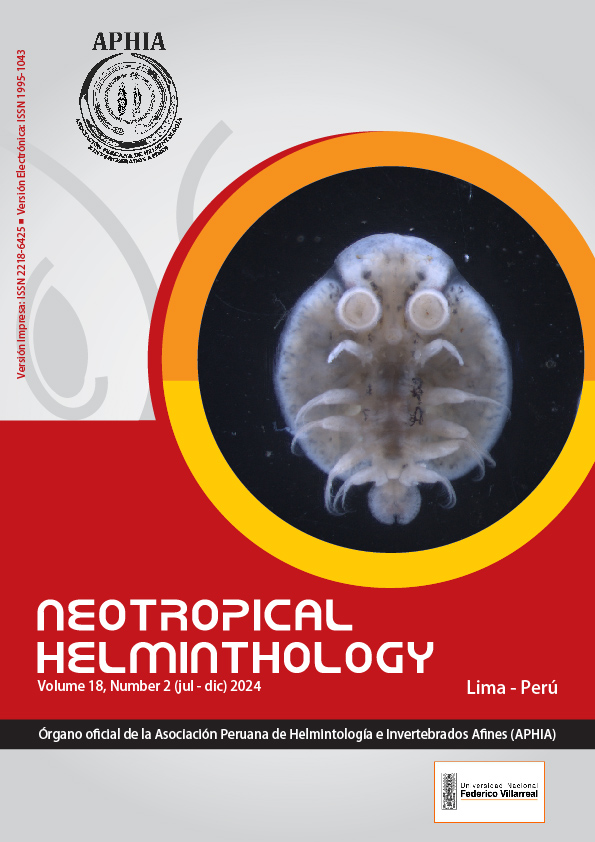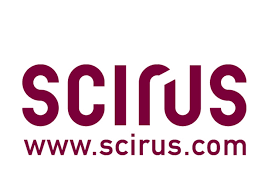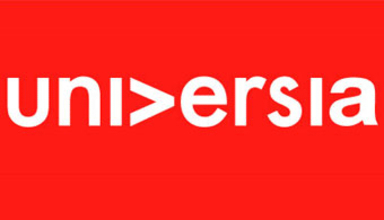Synthesium pantoporiae and Synthesium tursionis (Digenea; Brachycladiidae Odhner, 1905) in Pontoporia blainvillei Gervais & d’Orbigny, 1844 (Cetacea, Pontoporiidae) in south of the state of Santa Catarina, Brazil
DOI:
https://doi.org/10.62429/rnh20242181821Keywords:
Beaches, Cetacean, Digenetic, TrematodeAbstract
Parasitic susceptibility can occur indidually or in populations due to several factors, such as: parasite species, abundance, host health status (age, nutritional status) and competition between diferente types of parasites. This study reports the presence of Synthesium pontoporiae Raga, Aznar, Balbuena & Dailey, 1994 and Synthesium tursionis (Marchi, 1873) in Pontoporia blainvillei Gervais & D’Orbigny, 1844 found dead on the beaches of the mucipalities of Laguna, Imbituba and Garopaba, located on the southern coast of Santa Catarina, Brazil, between 2017 until 2020. A total of 144 specimens of trematodes were identified in 14 evaluated animals, with a prevalence of 35,71%, mean abundance of 10.28 and mean intensity of infection of 28.80. The average intestinal lenght was 8.96 meters, ranging from 1.90 to 29.10 meters. The occurence of parasites can be indicative of the relationship between feeding habits and the dispersion of animals in the ocean and, in the case of the presence of the Synthesium trematode, this knowledge is fundamental in the research for more information about the evolutionary cycle of this parasite. In this study, although the beaches where the animals were found are geographically very close, there were significant diferences, mainly between the intensity and parasite abundance, which demonstrates the need for further studies to understand the relationship between the findings in this study with the diet and the presence of possible intermediate hosts of this parasite in these regions.
Downloads
Published
How to Cite
Issue
Section
License

This work is licensed under a Creative Commons Attribution-NonCommercial-NoDerivatives 4.0 International License.
OBJETO: El AUTOR-CEDENTE transfiere de manera TOTAL Y SIN LIMITACIÓN alguna al CESIONARIO los derechos patrimoniales que le corresponden sobre la (s) obra(s) tituladas: xxxxxxxxxxxxxxxx, por el tiempo que establezca la ley internacional. En virtud de lo anterior, se entiende que el CESIONARIO adquiere el derecho de reproducción en todas sus modalidades, incluso para inclusión audiovisual; el derecho de transformación o adaptación, comunicación pública, traducción, distribución y, en general, cualquier tipo de explotación que de las obras se pueda realizar por cualquier medio conocido o por conocer en el territorio nacional o internacional.
REMUNERACIÓN: La cesión de los derechos patrimoniales de autor que mediante este contrato se hace será a título gratuito.
CONDICIONES Y LEGITIMIDAD DE LOS DERECHOS: El AUTOR-CEDENTE garantiza que es propietario integral de los derechos de explotación de la(s) obra(s) y en consecuencia garantiza que puede contratar y transferir los derechos aquí cedidos sin ningún tipo de limitación por no tener ningún tipo de gravamen, limitación o disposición. En todo caso, responderá por cualquier reclamo que en materia de derecho de autor se pueda presentar, exonerando de cualquier responsabilidad al CESIONARIO.
LICENCIA DE ACCESO ABIERTO: El AUTOR-CEDENTE autoriza que manuscrito publicado en La Revista Neotropical Helminthology permanece disponible para su consulta pública en el sitio web https://www.neotropicalhelminthology.com/ y en los diferentes sistemas de indexación y bases de datos en las que la revista tiene visibilidad, bajo la licencia Creative Commons, en la modalidad Reconocimiento-No comercial- Sin Trabajos derivados –aprobada en Perú, y por lo tanto son de acceso abierto. De ahí que los autores dan, sin derecho a retribución económica, a la Asociación Peruana de Helmintología e Invertebrados Afines (APHIA), los derechos de autor para la edición y reproducción a través de diferentes medios de difusión.


 Numero 2 Volumen 19 - 2025 (versión Anticipada)
Numero 2 Volumen 19 - 2025 (versión Anticipada)














































